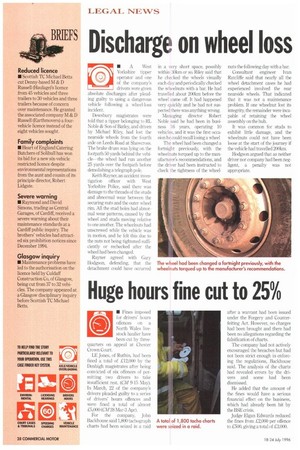Discharge on wheel loss
Page 30

If you've noticed an error in this article please click here to report it so we can fix it.
• A West Yorkshire tipper operator and one of the company's drivers were given absolute discharges after pleading guilty to using a dangerous vehicle following a wheel-loss incident.
Dewsbury magistrates were told that a tipper belonging to RL Noble & Son of Batley, and driven by Michael Riley, had lost the nearside wheels from the fourth axle on Leeds Road at Shawcross. The brake drum was lying on the footpath 50 yards behind the vehicle—the wheel had run another 25 yards over the footpath before demolishing a telegraph pole.
Keith Rayner, an accident investigation officer with West Yorkshire Police, said there was damage to the threads of the studs and abnormal wear between the securing nuts and the outer wheel rim. All the stud holes had abnormal wear patterns, caused by the wheel and studs moving relative to one another. The wheelnuts had unscrewed while the vehicle was in motion, and he felt this due to the nuts not being tightened sufficiently or rechecked after the wheel had been changed.
Rayner agreed with Gary Hodgson, defending, that the detachment could have occurred in a very short space, possibly within :10km or so. Riley said that he checked the wheels visually each day and periodically checked the wheelnuts with a bar. He had travelled about 200km before the wheel came off. It had happened very quickly and he had not suspected there was anything wrong.
Managing director Robert Noble said he had been in business 16 years, operating 10 vehicles, and it was the first occasion he could recall losing a wheel The wheel had been changed a fortnight previously, with the wheelnuts torqued up to the manufacturer's recommendations, and the driver had been instructed to check the tightness of the wheel nuts the following day with a bar.
Consultant engineer Ivan Ratcliffe said that nearly all the wheel detachment cases he had experienced involved the rear nearside wheels. That indicated that it was not a maintenance problem. If one wheelnut lost its integrity, the remainder were incapable of retaining the wheel assembly on the hub.
It was common for studs to exhibit little damage, and the wheelnuts could not have been loose at the start of the journey if the vehicle had travelled 2001cm.
Hodgson argued that as neither driver nor company had been negligent, a penalty was not appropriate.












































































































